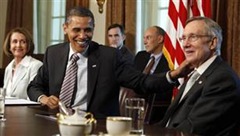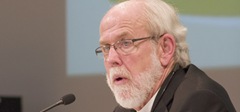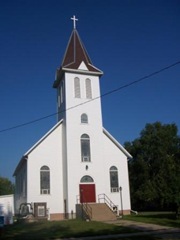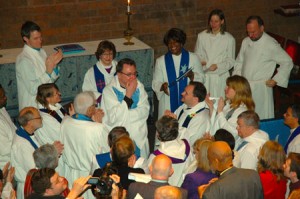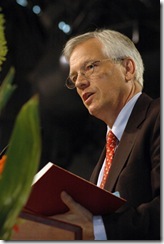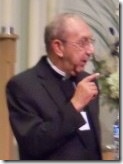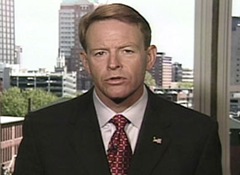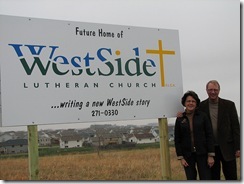In the final days of 2010, I will reprint the top posts of the year based upon reader views according to my WordPress site stats. At the top of the list is the August 30th post that discussed the open letter of retired ELCA presiding Bishop Herb Chilstrom. That post attracted over 2,200 unique visitors and two pages of reader comments. Here is link to the original post with comments, and the post itself is reprinted below in its entirety.
 Since the formation of the ELCA in 1988, the denomination has been shepherded by three presiding Bishops: Herb Chilstrom, H George Anderson, and currently Mark Hanson. Herb and wife Corrine now reside in retirement in St. Peter, Minnesota. On August 26th, Herb penned an op-ed piece for the newspaper in nearby Mankato—his response to the formation of the North American Lutheran Church (NALC) as a splinter from the ELCA. Bishop Chilstrom asked three rhetorical questions of those who have departed the ELCA for NALC, Lutheran Congregations in Mission for Christ (LCMC), or another church body.
Since the formation of the ELCA in 1988, the denomination has been shepherded by three presiding Bishops: Herb Chilstrom, H George Anderson, and currently Mark Hanson. Herb and wife Corrine now reside in retirement in St. Peter, Minnesota. On August 26th, Herb penned an op-ed piece for the newspaper in nearby Mankato—his response to the formation of the North American Lutheran Church (NALC) as a splinter from the ELCA. Bishop Chilstrom asked three rhetorical questions of those who have departed the ELCA for NALC, Lutheran Congregations in Mission for Christ (LCMC), or another church body.
First, what is it about sex that pushed you over the edge?
The retired Bishop wonders why some elevate questions of sexual behavior over more momentous issues such as abortion, war and peace, and the death penalty. What is it about the sexual behavior of others that causes such a visceral outcry and schismatic response?
[Other issues seem] far more serious than getting upset about two adults of the same gender who, like most of us straight folks, chose to live peacefully in a life-long relationship — the only such pairing the ELCA has approved. Like their straight neighbors, they live peacefully, go to their jobs every morning, pay their taxes, volunteer for good causes and, in many cases, worship with us. What is it that upsets you about this?
Ah, the straw that broke the camel’s back comes the response. The various dissident groups go to great lengths to suggest that LGBT issues were merely the tipping point that reflects a lengthy ELCA drift away from tradition and traditional Biblical interpretations. To be sure, LCMC was formed nearly a decade ago, and many LCMC congregations departed the ELCA prior to CWA09 (but the LCMC has doubled in size since CWA09).
Here is my take. CWA09 resolutions were not the tipping point but the opportunity seized upon by long time ELCA detractors to scare the the folks in the pews into following their leadership. For much of the hierarchy of WordAlone, CORE, NALC, and even LCMC, their disaffection with the ELCA goes back to the very beginning, and it can all be summed up in one word—CONTROL. This blog has previously critiqued the comments of dissident theologians Nestingen, Braaten, and Benne who in similar ways lamented the egalitarian impulses of the newly formed ELCA thereby diminishing the power of the male elites. Over the years, this coterie repeatedly attempted, unsuccessfully, to achieve leadership status within the ELCA.
But then came CWA09. They saw their chance and they took it. CWA09 handed the dissidents a cultural wedge issue that they could use to drive ELCA congregants and congregations away from the ELCA and into their own organization, under their control. So, Herb, it is not about sex. Nor is it truly about Biblical interpretation. Here the Missouri Synod critique of the new Lutheran church bodies makes sense—if these new organizations truly want to be Biblical traditionalists, why do they allow female clergy? Or divorced clergy? The existence of female and divorced clergy within their ranks puts the lie to the claim that it is all about strict and traditional Biblical interpretation. No, Herb, it is something else. It is all about power and control.
Here is Bishop Chilstrom’s second question:
Second, why are you organizing new churches?
Surely there must be one among them [existing Lutheran bodies] that would welcome you. Why go to all the unnecessary expense of setting up an entirely new structure with officers, boards, committees and institutions?
This might be a good place to interject some basic data about the numerous small and uniformly conservative Lutheran Church bodies that exist in the US in open criticism of the more-progressive ELCA. For comparison, the ELCA has over 10,000 congregations and over 4 million members (statistics for each derived from Wikipedia or the organization’s website)
- Missouri Synod (LCMS) 2.4 million members
- Wisconsin Synod (WELS) 1,300 congregations
- Lutheran Congregations in Mission for Christ (LCMC) 500 congregations
- Free Lutheran Churches (AFLC) 270 congregations
- Lutheran Brethren 123 Congregations
- North American Lutheran Church (NALC) 18 congregations.
Bishop Chilstrom assumes the reason why LCMC and NALC don’t join one of the other bodies is because LCMC and NALC will continue to ordain women as their legacy from the ELCA. I know the LCMC is attempting to to position itself as the moderate middle of Lutherandom with the more progressive ELCA on the left and the more conservative others on the right. There would also appear to be an organizational difference between LCMC (congregational autonomy) and NALC (a denominational structure). I have previously characterized LCMC as a website and a mailing list. Their organizational paid staff is minimal. No seminaries, no colleges, no candidacy committees, no disaster relief, no missionary support, no … fill in the blank. It is merely an affiliation of like minded congregations that are free to do their own thing with minimal organizational support or control.
There’s that word again. CONTROL. See the answer to number 1, Herb.
Here is Bishop Chilstrom’s final question:
Third, what will you say to your sons and daughters, sisters and brothers and others in your churches when they tell you they are homosexual?
This is the nub of it. We can argue about “gay issues” till we’re blue in the face, but we miss the human element. This not some academic argument; this is about real lives, children of God, baptized brothers and sisters. I asked last week how many church bulletins proclaim “all are welcome”—and really mean it.
“What will you say to your sons and daughters?” Herb asks.
Will you offer empty platitudes (hate the sin but love the sinner)? Will you “pray the gay away?” Will you offer junk science such as reparative therapy that will only deepen their pain? Will you turn your back or offer an embrace?
Retired Pastor Duane from my congregation tells the story of the gay high school boy who came out to him and then asked Duane to accompany him when he came out to his parents.
Mom came out of the kitchen, wiping her hands on her apron, with a worried look on her face when the pair arrived in the driveway.
“Mom, I’m gay,” the boy said.
“Is that all?” and mom smiled with relief and gave her son a hug.
They were still in the driveway when dad arrived in the pickup with mud flaps and a rifle slung in the rear window. He exited the cab with a mixed expression of anger and concern.
“Dad, I’m gay”, the son said.
Dad’s face drained of all color, and his eyes turned black. He looked at his son, his wife, Pastor Duane, and back at his son. Then, his eyes moistened and his lips quivered.
“I don’t understand,” he said, his voice cracking, “and I probably never will. But, you’re my son, and I love you.” Father and son fell into each other’s arms, shaking and sobbing.
This isn’t about doctrine, or confessionalism, or Biblical interpretation, and it ought not be about control. This is about grace. This is about trust. Let go and let God. Listen to the wisdom of Herb Chilstrom:
I am both sad and relieved that you are leaving. Sad, because this was not what we hoped for when the ELCA was formed some 22 years ago. We believed we could be a church where we held to the essentials and allowed for differences on non-essentials.
But I am also relieved. Now those of us who remain in the ELCA can get on with our primary mission of telling everyone — everyone — “Jesus loves you. You are welcome in this church.”


